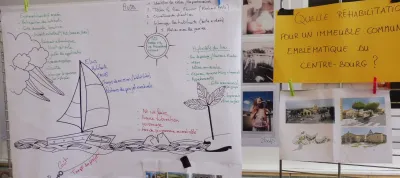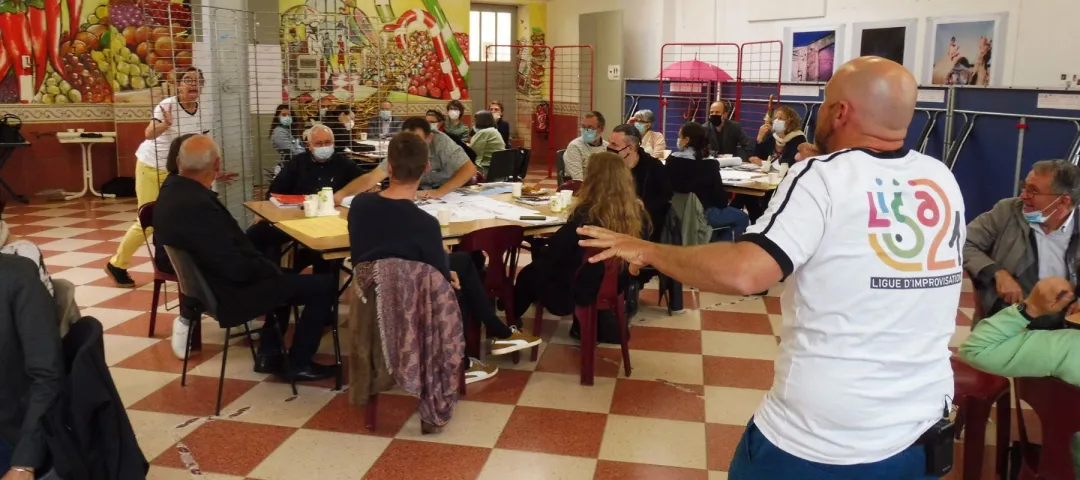General information
RDP Priority
- P6. Social inclusion and local development
RDP Focus Area
- 6B: Local development
RDP Measure
- M19: LEADER/CLLD
Beneficiary type
- Public authority / body
Summary
The 'Windows Open on Rural Towns' project addressed the decline of small towns and villages by engaging elected representatives, civil servants and citizens in the collective task of initiating and implementing new solutions for revitalising rural areas.
With the aim of reimagining rural areas and rejuvenating small-town centres in the five participating LEADER territories, the project delivered three connected activities: training sessions, information seminars, and knowledge transfer and capitalisation activities.
Results
- The project set the foundations for new initiatives to be developed locally, focusing on local food systems, building renovations, etc.
- It also helped to create links with newcomers in the partner territories, many of whom have joined local associations and created new businesses.

Promoter
Parc Naturel Régional du Morvan
Funding
Total budget 101 946 (EUR)
EAFRD: 68 737 (EUR)
National/Regional: 33 209 (EUR)
Ressources
Documents
Good Practice Report - LEADER focuses on reimagining rural areas and rejuvenating smalltown centres in France
(PDF – 3.03 Mo)
Liens
Context
The 'Windows Open on Rural Towns' project addresses the declining vitality of small towns and villages. It brings together five LEADER territories in France: the regional natural park of Morvan, Gâtine County, Lot Valley, the LEADER Forez Territory and the Châtaigneraie Limousine Territory. Initiated in 2018, the project stemmed from the observation that all of these rural areas were declining in attractiveness, in large part due to a steady reduction in local services for the population. Additionally, the inhabitants expressed a desire to share their experiences and be actively involved in the revitalisation of their villages. To tackle these challenges, elected representatives and local associations collaborated to develop several activities, including sharing best practices and testing solutions.
Objectives
The aims of this project included:
- Exchange ideas, share knowledge and capitalise on past experiences from other rural areas.
- Enabling local stakeholders to acquire the skills to contribute actively to local development.
- Co-design transferable solutions with citizens and elected representatives, implemented with the aim of revitalising rural areas.
Activities
The project delivered three types of actions, split into several different activities:
- Organising a cycle of five seminars: These seminars targeted elected representatives and civil servants from local public authorities. The seminars aimed to equip participants with skills and knowledge concerning the revitalisation of town centres. Objectives included sharing good practices and learning about methodologies for revitalisation actions (e.g. local planning and building restoration).
- The first seminar took place in 2019 in the Lot Valley LAG. It featured debates and panel discussions on topics such as the reuse of buildings, housing needs, the creation of new commercial activities (shops/companies) and cultural dialogue.
- The second seminar took place in 2020 in the Loire Forez territory LAG. The theme was 'Together to Bring Our Town Centers Back to Life' with a focus on citizen engagement and participation.
- The third seminar focused on 'Living in a Town Centre: Giving Life to Built Heritage' and included testimonies on developing partnerships with social landlords, for example.
- The fourth seminar, held in 2021, focused on youth in rural areas and presented actions to engage young people in rural life.
- The last seminar addressed the lack of services and shops in small town centres and offered a broader view by analysing French and European examples.
- Creating guides and documents: the project produced guides and documents for capitalising and transferring good practices based on the methodologies and experiences shared during the seminars. Project partners aimed to build resources to ensure the transfer of such examples. These capitalisation documents provide step-by-step instructions for developing certain practices and include contacts for 'resource persons' to support the process. The capitalisation actions comprised 22 videos featuring portraits/testimonies from newcomers or long-term inhabitants from the partner territories. Additionally, the partners created a guide, including examples of good practices and a toolbox.
- Organising training: two-day training sessions were organised for elected representatives to address the issue of revitalising small-town centres.
Main results
- This project launched a movement at local level and still has an impact on local projects. It set the foundations for new projects now being developed locally concerning local food systems, building renovations, etc.
- In addition, this project helped to create links with newcomers in the partner territories, many of whom have joined local associations and created new businesses.
Key lessons
- The involvement and training of local elected representatives were key success factors, facilitating the implementation of actions and their continuation in the medium term. Some of the elected representatives who participated in the project still act as spokespersons, informing other local public authorities about the revitalisation of rural town centres.
- Targeting newcomers in an area is also critical for successful actions aimed at revitalising town centres.
Benedicte Barret

